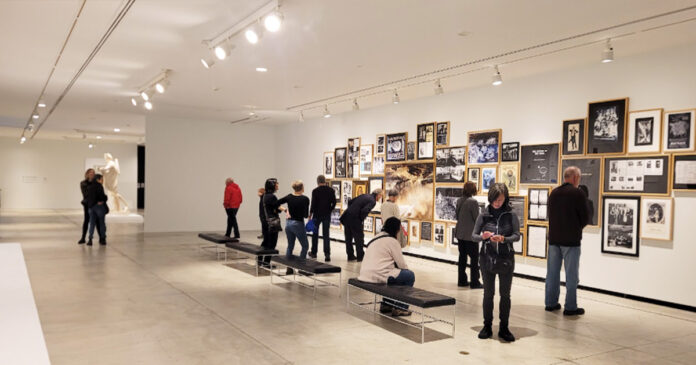A social media post about a hateful, anti-white exhibit at the Vancouver Art Gallery called “Conceptions of White” recently went viral, so naturally, I had to go see it for myself.
After you fork over your $30 admission fee (geez) and take the stairs to the third floor, the first thing to catch your eye is the giant phrase on the wall that reads, “When you’re the problem, we’re the solution.” The text is accompanied by a large headshot of a white male.

Gallery attendees then have the opportunity to interact with an AI program on a set of tablets.
“Stop talking. Never share an uninvited opinion again,” text on the wall reads. When you look into the tablet, a mute symbol is superimposed over your mouth.

“Check privilege. Learn whether you’re special or just lucky,” the text reads. Upon looking into the tablet, a halo that says “Undeserving” appears over your head.

“Get curious. Vocalize your own ignorance.”
The tablet prompts me to say aloud, “I know nothing.”

I sauntered over to the gallery security guard.
“Do people find this funny?” I asked her, gesturing at the tablet display. After all, the artist behind the work had described it as “tongue-in-cheek.”
“No,” she said, with a sheepish smile.
“They don’t like it?”
“No,” she shook her head.
I asked her whether this exhibit has been popular so far, but the answer was another negative.
“The Emily Carr exhibit is popular though,” she offered, referring to the famous Canadian painter.
I walked by some schizophrenic ramblings and pictures on the wall about how because statues from Ancient Rome and Greece had curly hair, they were probably not white people.

I arrived at a computer station with a webcam.
“Aryan Recognition Tool: How Aryan Are You?” the screen read.

The computer program claimed to measure how your face compared to the facial measurements of “the most infamous leaders of the Third Reich.”
Sign me up!

“Could face recognition be used to detect genocidal predators, or even casual racists? Find out whether your face matches any of the 1,900 examples of Aryans we’ve gathered.”
I was so eager to do so, but darn! An “out of order” sign was propped up in front of the facial recognition camera.

On to the next.
The next major installation was a timeline that spanned about 15 feet long.
“An incomplete timeline of the circumstances that influenced the emergence – and evolution – of White racial identity,” it read.

I learned that as a white Canadian born in the mid-1990s, my identity is defined by slavery, scientific racism, Rudyard Kipling’s 1899 poem “The White Man’s Burden,” colonialism, the Ku Klux Klan, the Third Reich, the “alt-right,” and Robin DiAngelo’s book White Fragility: Why It’s So Hard for White People to Talk About Racism.
The last items in the timeline of white terribleness were “2013: Black Lives Matter founded” and “2021: January 6 Insurrection.” I chortled.

I was exhausted at this point, and still so very dismayed that I paid $30 only for the Aryan facial recognition tool to be out of order.
The final installation was a short film that purported to be about reflecting the “current state of White identity in America.”
What followed was a 30-minute compilation of internet meme videos spliced with scenes of racial violence, guns, and creepy staring.
On the way out of the screening room, I asked a couple visiting Vancouver from Australia whether they liked the exhibit.
“I was horrified. Horrified, devastated, saddened,” the man said, before praising the exhibit and trailing off about “violence” and “so many wars.”
The man had been successfully programmed into hating his heritage.
We are a culture that preaches self-love: individuals should be self-confident, self-respecting, self-reliant. But how can white people love themselves if they are told repeatedly that they are oppressors, purveyors of violence, and racists just for existing?
Especially when it is the high-culture institutions like galleries, museums, and universities beating them over the head with this message? The “Conceptions of White” exhibit also received government funding through the Canada Council for the Arts.
The exhibit was palpably hateful and designed to demoralize. I left the gallery not inspired and infused with joie de vivre, but rather drained: it was as if I had just exited a zone of concentrated psychological warfare, and I had fortunately come out alive with my critical thinking faculties still intact.
The security guard had spoken highly of the Emily Carr exhibit, so I went upstairs to the fourth floor to gaze upon something beautiful for a change.
I read the paragraphs of text about Emily Carr’s life that accompanied her paintings.
“Carr proclaimed to document a ‘disappearing Indigenous culture’ by undertaking frequent sketching trips in the province and painting totemic sculptures and villages,” the text read.
“She was sincere in her effort to represent Indigenous villages and culture in her work, but naive of her own colonial response to Indigenous cultures and the exploitative and romanticizing effect of her artwork.”
Sigh.
Even up at this exhibit, the artist is scolded for “romanticizing,” by painting vibrant and expressive landscapes.
I’d had enough.
My trip to the Vancouver Art Gallery: 0 out of 5 stars.
